Microeconomics Assignment: Valuation, Recession, & More
VerifiedAdded on 2023/03/30
|9
|1728
|109
Homework Assignment
AI Summary
This assignment delves into key microeconomic concepts, beginning with an analysis of dollar valuation, distinguishing between nominal and real values, and examining the impact of inflation. It then differentiates between economic recessions and depressions, outlining their characteristics and the varying saving behaviors of individuals who have lived through different economic periods. The assignment continues by exploring supply and demand dynamics, calculating equilibrium prices and quantities in a closed economy and subsequently analyzing the effects of opening up to international trade and the application of tariffs. Finally, the assignment addresses different types of unemployment, including natural, cyclical, frictional, and structural unemployment, and discusses key trends in the Australian labor market, such as changes in employment and unemployment rates. The analysis is supported by relevant economic theories and practical examples, making it a comprehensive study of microeconomic principles.
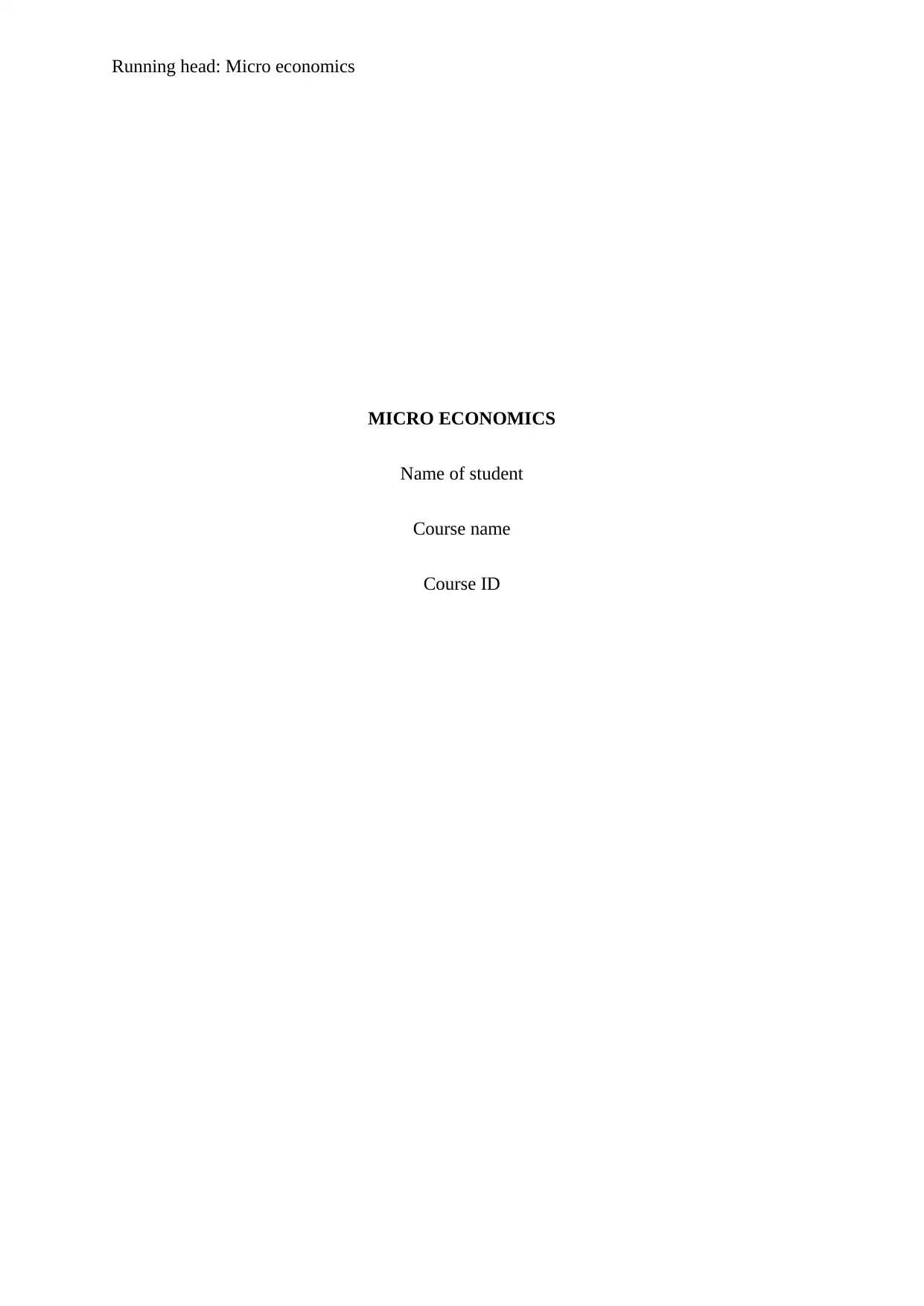
Running head: Micro economics
MICRO ECONOMICS
Name of student
Course name
Course ID
MICRO ECONOMICS
Name of student
Course name
Course ID
Paraphrase This Document
Need a fresh take? Get an instant paraphrase of this document with our AI Paraphraser
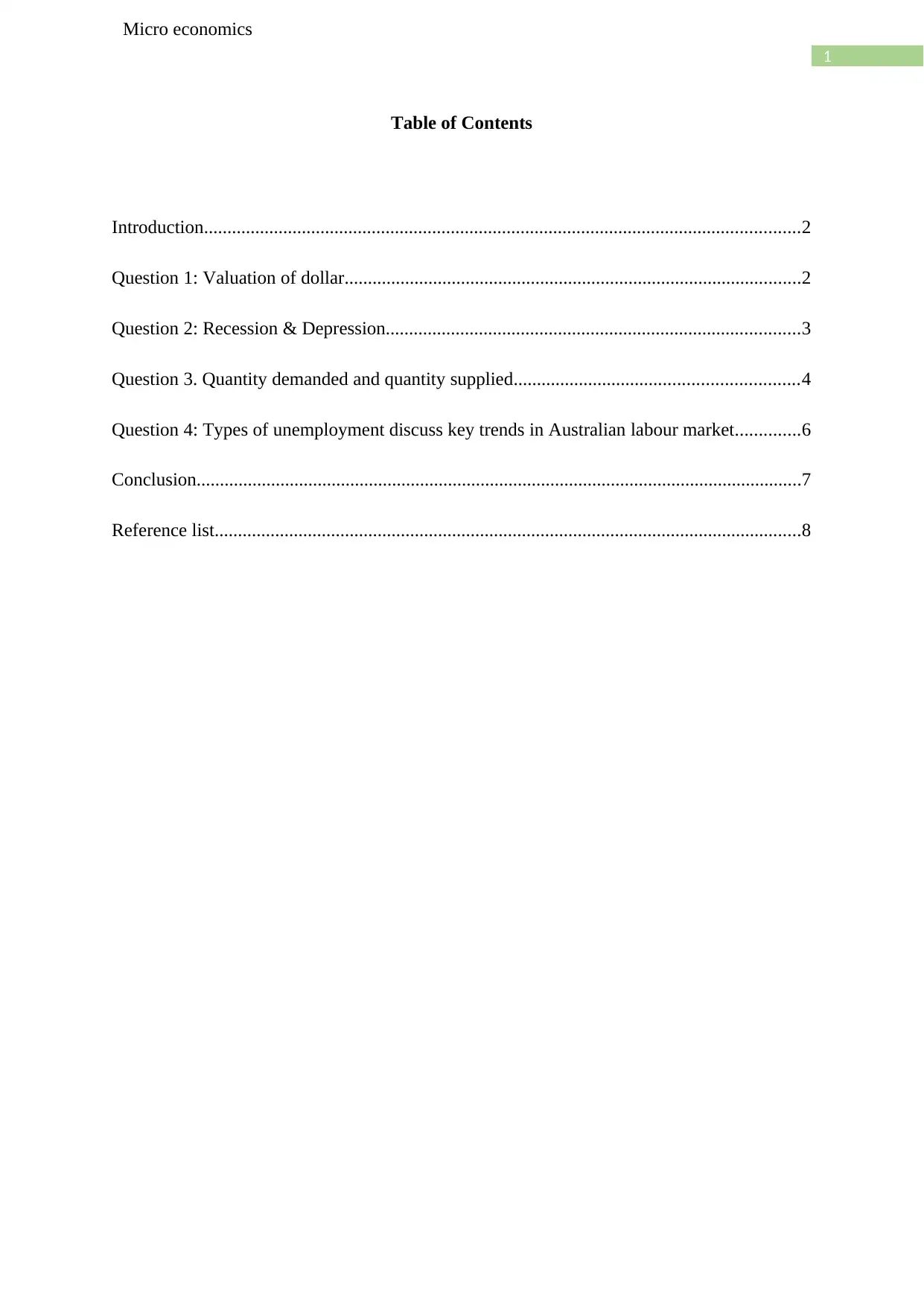
1
Micro economics
Table of Contents
Introduction................................................................................................................................2
Question 1: Valuation of dollar..................................................................................................2
Question 2: Recession & Depression.........................................................................................3
Question 3. Quantity demanded and quantity supplied.............................................................4
Question 4: Types of unemployment discuss key trends in Australian labour market..............6
Conclusion..................................................................................................................................7
Reference list..............................................................................................................................8
Micro economics
Table of Contents
Introduction................................................................................................................................2
Question 1: Valuation of dollar..................................................................................................2
Question 2: Recession & Depression.........................................................................................3
Question 3. Quantity demanded and quantity supplied.............................................................4
Question 4: Types of unemployment discuss key trends in Australian labour market..............6
Conclusion..................................................................................................................................7
Reference list..............................................................................................................................8
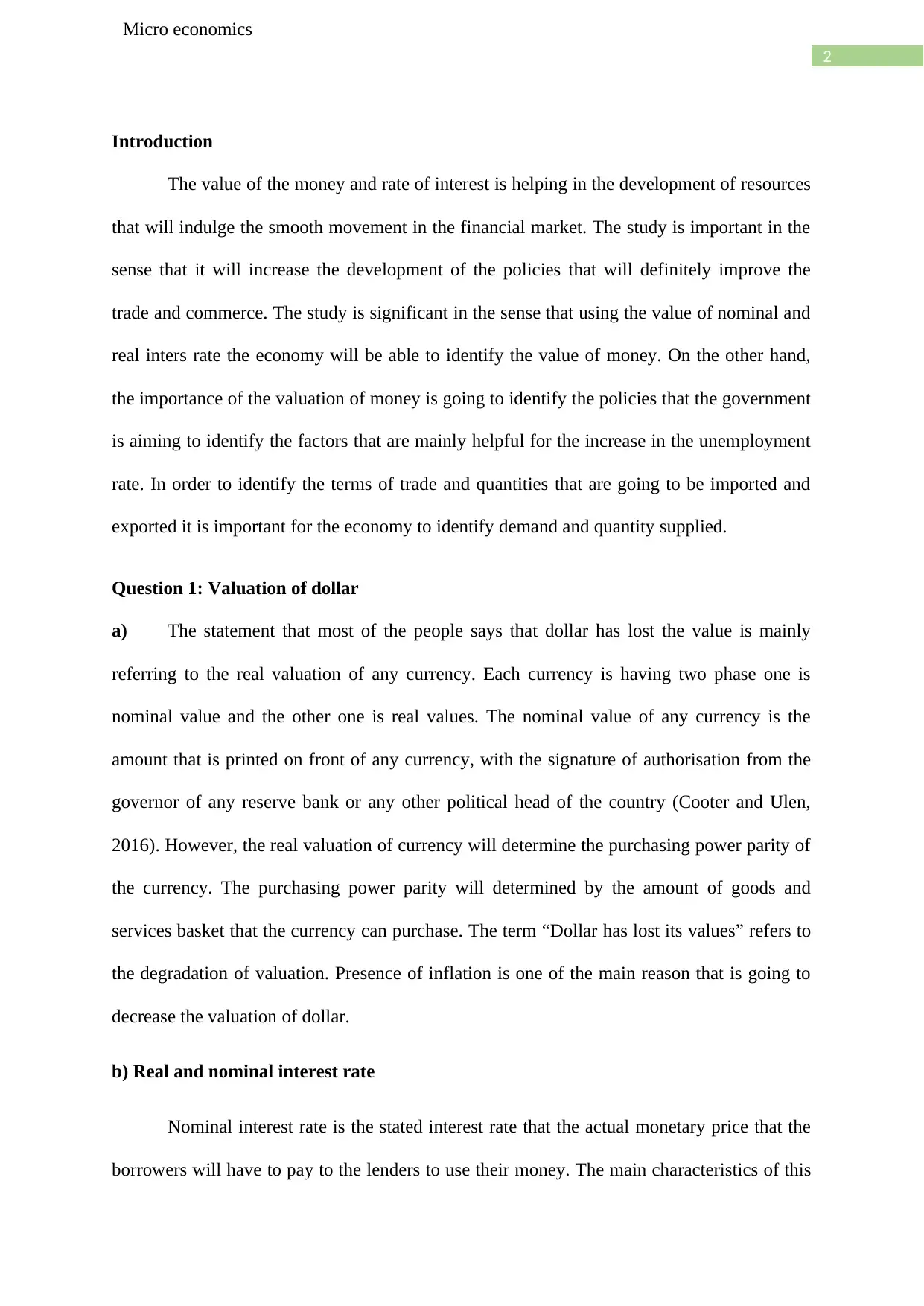
2
Micro economics
Introduction
The value of the money and rate of interest is helping in the development of resources
that will indulge the smooth movement in the financial market. The study is important in the
sense that it will increase the development of the policies that will definitely improve the
trade and commerce. The study is significant in the sense that using the value of nominal and
real inters rate the economy will be able to identify the value of money. On the other hand,
the importance of the valuation of money is going to identify the policies that the government
is aiming to identify the factors that are mainly helpful for the increase in the unemployment
rate. In order to identify the terms of trade and quantities that are going to be imported and
exported it is important for the economy to identify demand and quantity supplied.
Question 1: Valuation of dollar
a) The statement that most of the people says that dollar has lost the value is mainly
referring to the real valuation of any currency. Each currency is having two phase one is
nominal value and the other one is real values. The nominal value of any currency is the
amount that is printed on front of any currency, with the signature of authorisation from the
governor of any reserve bank or any other political head of the country (Cooter and Ulen,
2016). However, the real valuation of currency will determine the purchasing power parity of
the currency. The purchasing power parity will determined by the amount of goods and
services basket that the currency can purchase. The term “Dollar has lost its values” refers to
the degradation of valuation. Presence of inflation is one of the main reason that is going to
decrease the valuation of dollar.
b) Real and nominal interest rate
Nominal interest rate is the stated interest rate that the actual monetary price that the
borrowers will have to pay to the lenders to use their money. The main characteristics of this
Micro economics
Introduction
The value of the money and rate of interest is helping in the development of resources
that will indulge the smooth movement in the financial market. The study is important in the
sense that it will increase the development of the policies that will definitely improve the
trade and commerce. The study is significant in the sense that using the value of nominal and
real inters rate the economy will be able to identify the value of money. On the other hand,
the importance of the valuation of money is going to identify the policies that the government
is aiming to identify the factors that are mainly helpful for the increase in the unemployment
rate. In order to identify the terms of trade and quantities that are going to be imported and
exported it is important for the economy to identify demand and quantity supplied.
Question 1: Valuation of dollar
a) The statement that most of the people says that dollar has lost the value is mainly
referring to the real valuation of any currency. Each currency is having two phase one is
nominal value and the other one is real values. The nominal value of any currency is the
amount that is printed on front of any currency, with the signature of authorisation from the
governor of any reserve bank or any other political head of the country (Cooter and Ulen,
2016). However, the real valuation of currency will determine the purchasing power parity of
the currency. The purchasing power parity will determined by the amount of goods and
services basket that the currency can purchase. The term “Dollar has lost its values” refers to
the degradation of valuation. Presence of inflation is one of the main reason that is going to
decrease the valuation of dollar.
b) Real and nominal interest rate
Nominal interest rate is the stated interest rate that the actual monetary price that the
borrowers will have to pay to the lenders to use their money. The main characteristics of this
⊘ This is a preview!⊘
Do you want full access?
Subscribe today to unlock all pages.

Trusted by 1+ million students worldwide
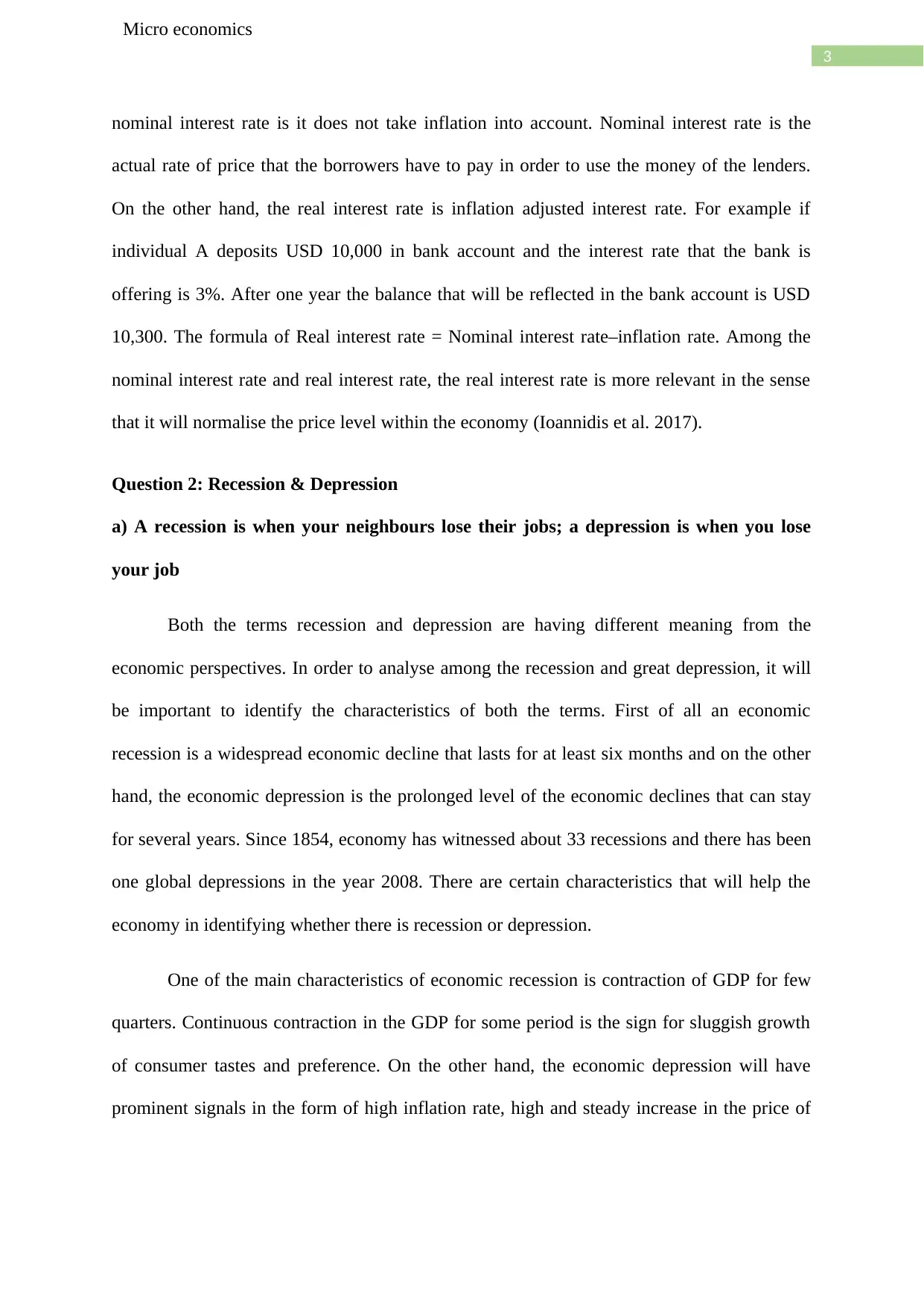
3
Micro economics
nominal interest rate is it does not take inflation into account. Nominal interest rate is the
actual rate of price that the borrowers have to pay in order to use the money of the lenders.
On the other hand, the real interest rate is inflation adjusted interest rate. For example if
individual A deposits USD 10,000 in bank account and the interest rate that the bank is
offering is 3%. After one year the balance that will be reflected in the bank account is USD
10,300. The formula of Real interest rate = Nominal interest rate–inflation rate. Among the
nominal interest rate and real interest rate, the real interest rate is more relevant in the sense
that it will normalise the price level within the economy (Ioannidis et al. 2017).
Question 2: Recession & Depression
a) A recession is when your neighbours lose their jobs; a depression is when you lose
your job
Both the terms recession and depression are having different meaning from the
economic perspectives. In order to analyse among the recession and great depression, it will
be important to identify the characteristics of both the terms. First of all an economic
recession is a widespread economic decline that lasts for at least six months and on the other
hand, the economic depression is the prolonged level of the economic declines that can stay
for several years. Since 1854, economy has witnessed about 33 recessions and there has been
one global depressions in the year 2008. There are certain characteristics that will help the
economy in identifying whether there is recession or depression.
One of the main characteristics of economic recession is contraction of GDP for few
quarters. Continuous contraction in the GDP for some period is the sign for sluggish growth
of consumer tastes and preference. On the other hand, the economic depression will have
prominent signals in the form of high inflation rate, high and steady increase in the price of
Micro economics
nominal interest rate is it does not take inflation into account. Nominal interest rate is the
actual rate of price that the borrowers have to pay in order to use the money of the lenders.
On the other hand, the real interest rate is inflation adjusted interest rate. For example if
individual A deposits USD 10,000 in bank account and the interest rate that the bank is
offering is 3%. After one year the balance that will be reflected in the bank account is USD
10,300. The formula of Real interest rate = Nominal interest rate–inflation rate. Among the
nominal interest rate and real interest rate, the real interest rate is more relevant in the sense
that it will normalise the price level within the economy (Ioannidis et al. 2017).
Question 2: Recession & Depression
a) A recession is when your neighbours lose their jobs; a depression is when you lose
your job
Both the terms recession and depression are having different meaning from the
economic perspectives. In order to analyse among the recession and great depression, it will
be important to identify the characteristics of both the terms. First of all an economic
recession is a widespread economic decline that lasts for at least six months and on the other
hand, the economic depression is the prolonged level of the economic declines that can stay
for several years. Since 1854, economy has witnessed about 33 recessions and there has been
one global depressions in the year 2008. There are certain characteristics that will help the
economy in identifying whether there is recession or depression.
One of the main characteristics of economic recession is contraction of GDP for few
quarters. Continuous contraction in the GDP for some period is the sign for sluggish growth
of consumer tastes and preference. On the other hand, the economic depression will have
prominent signals in the form of high inflation rate, high and steady increase in the price of
Paraphrase This Document
Need a fresh take? Get an instant paraphrase of this document with our AI Paraphraser
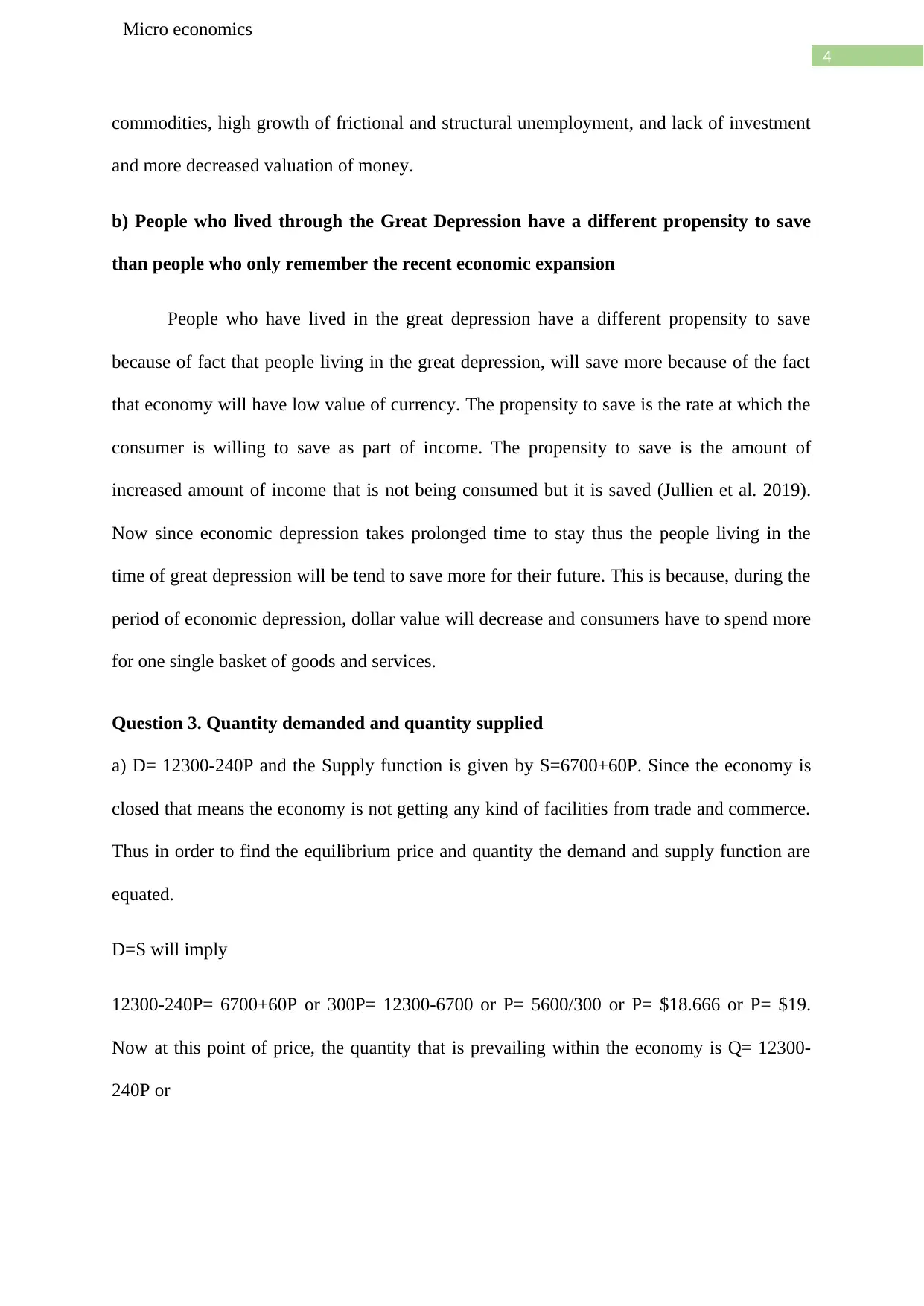
4
Micro economics
commodities, high growth of frictional and structural unemployment, and lack of investment
and more decreased valuation of money.
b) People who lived through the Great Depression have a different propensity to save
than people who only remember the recent economic expansion
People who have lived in the great depression have a different propensity to save
because of fact that people living in the great depression, will save more because of the fact
that economy will have low value of currency. The propensity to save is the rate at which the
consumer is willing to save as part of income. The propensity to save is the amount of
increased amount of income that is not being consumed but it is saved (Jullien et al. 2019).
Now since economic depression takes prolonged time to stay thus the people living in the
time of great depression will be tend to save more for their future. This is because, during the
period of economic depression, dollar value will decrease and consumers have to spend more
for one single basket of goods and services.
Question 3. Quantity demanded and quantity supplied
a) D= 12300-240P and the Supply function is given by S=6700+60P. Since the economy is
closed that means the economy is not getting any kind of facilities from trade and commerce.
Thus in order to find the equilibrium price and quantity the demand and supply function are
equated.
D=S will imply
12300-240P= 6700+60P or 300P= 12300-6700 or P= 5600/300 or P= $18.666 or P= $19.
Now at this point of price, the quantity that is prevailing within the economy is Q= 12300-
240P or
Micro economics
commodities, high growth of frictional and structural unemployment, and lack of investment
and more decreased valuation of money.
b) People who lived through the Great Depression have a different propensity to save
than people who only remember the recent economic expansion
People who have lived in the great depression have a different propensity to save
because of fact that people living in the great depression, will save more because of the fact
that economy will have low value of currency. The propensity to save is the rate at which the
consumer is willing to save as part of income. The propensity to save is the amount of
increased amount of income that is not being consumed but it is saved (Jullien et al. 2019).
Now since economic depression takes prolonged time to stay thus the people living in the
time of great depression will be tend to save more for their future. This is because, during the
period of economic depression, dollar value will decrease and consumers have to spend more
for one single basket of goods and services.
Question 3. Quantity demanded and quantity supplied
a) D= 12300-240P and the Supply function is given by S=6700+60P. Since the economy is
closed that means the economy is not getting any kind of facilities from trade and commerce.
Thus in order to find the equilibrium price and quantity the demand and supply function are
equated.
D=S will imply
12300-240P= 6700+60P or 300P= 12300-6700 or P= 5600/300 or P= $18.666 or P= $19.
Now at this point of price, the quantity that is prevailing within the economy is Q= 12300-
240P or
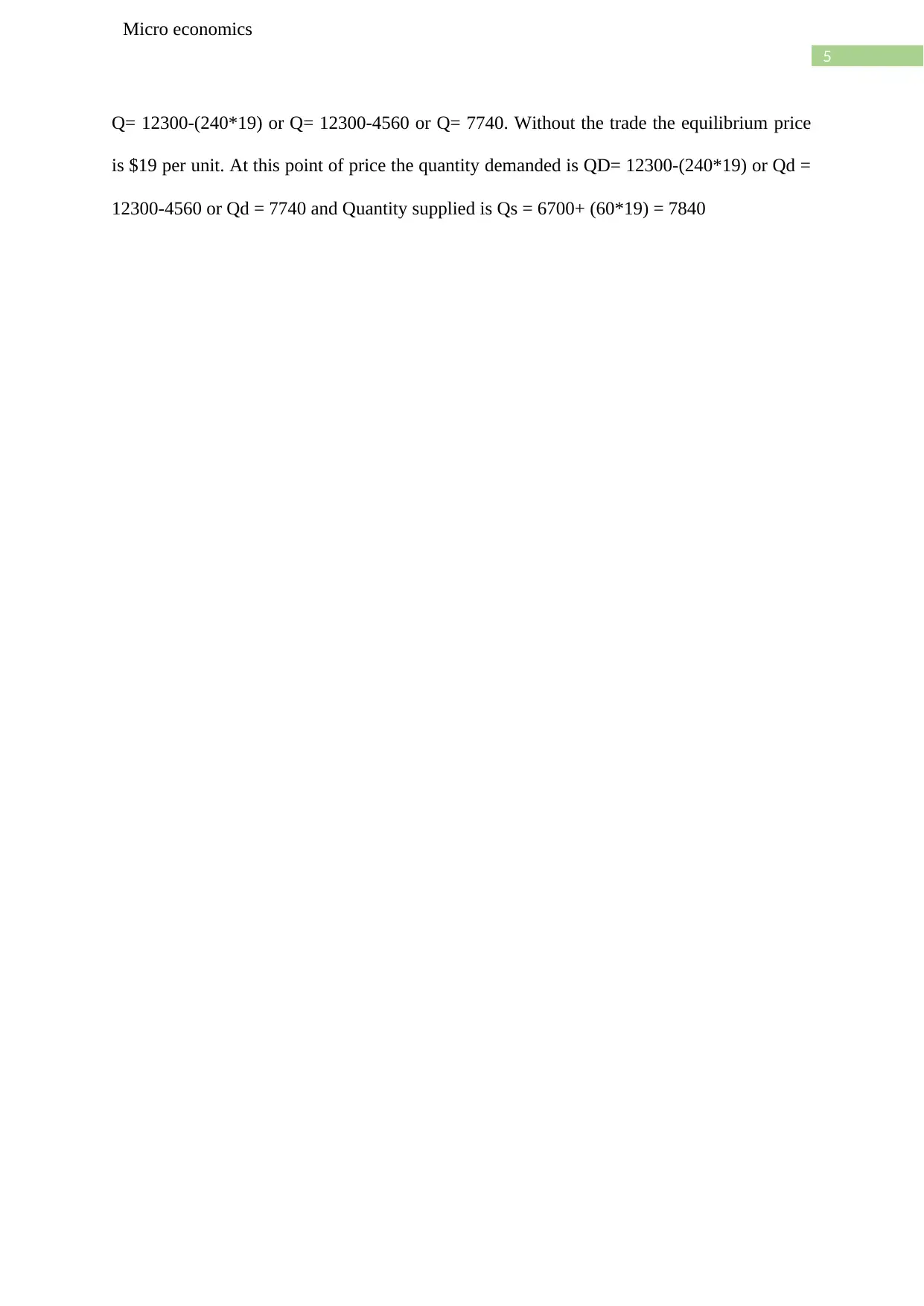
5
Micro economics
Q= 12300-(240*19) or Q= 12300-4560 or Q= 7740. Without the trade the equilibrium price
is $19 per unit. At this point of price the quantity demanded is QD= 12300-(240*19) or Qd =
12300-4560 or Qd = 7740 and Quantity supplied is Qs = 6700+ (60*19) = 7840
Micro economics
Q= 12300-(240*19) or Q= 12300-4560 or Q= 7740. Without the trade the equilibrium price
is $19 per unit. At this point of price the quantity demanded is QD= 12300-(240*19) or Qd =
12300-4560 or Qd = 7740 and Quantity supplied is Qs = 6700+ (60*19) = 7840
⊘ This is a preview!⊘
Do you want full access?
Subscribe today to unlock all pages.

Trusted by 1+ million students worldwide
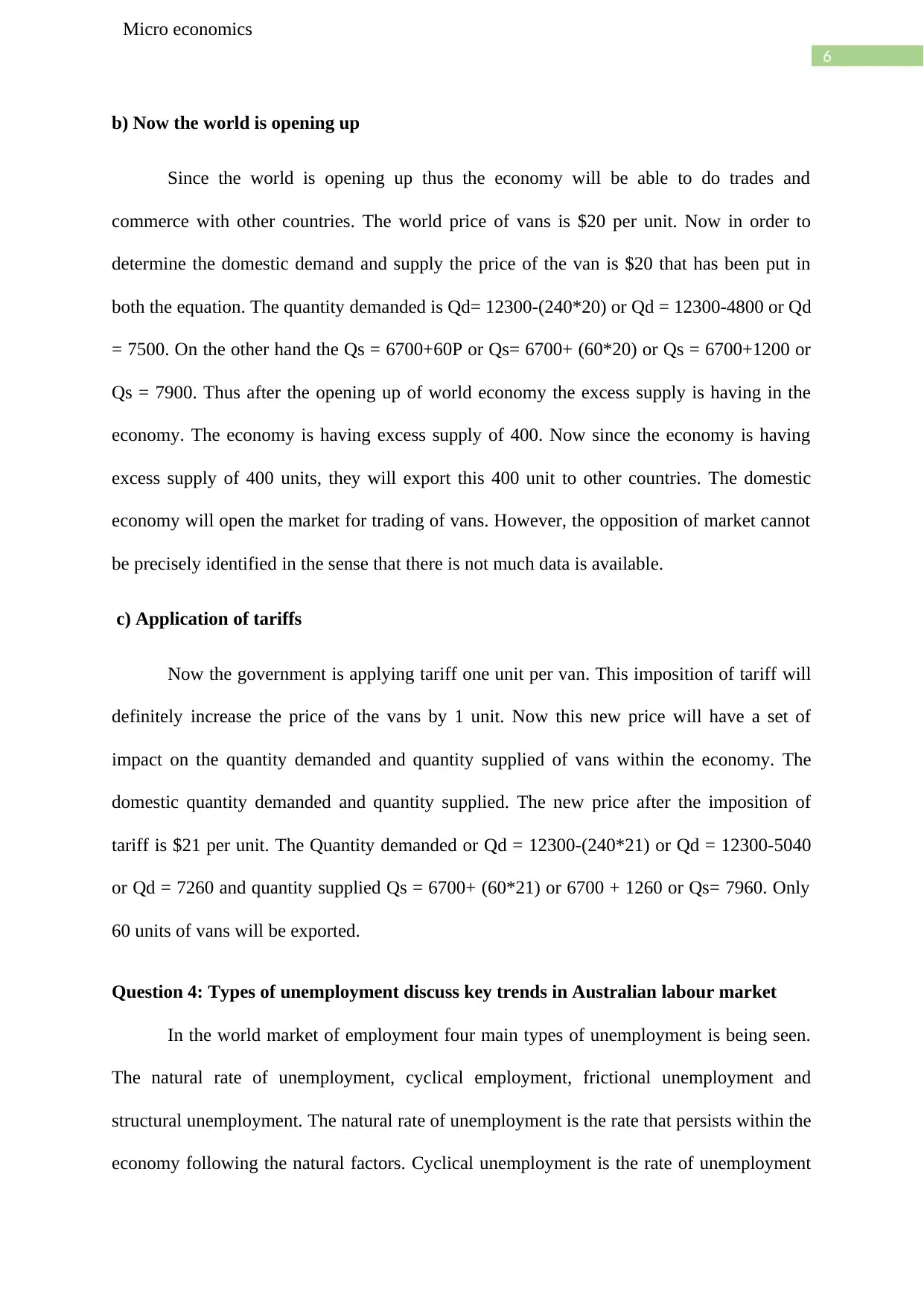
6
Micro economics
b) Now the world is opening up
Since the world is opening up thus the economy will be able to do trades and
commerce with other countries. The world price of vans is $20 per unit. Now in order to
determine the domestic demand and supply the price of the van is $20 that has been put in
both the equation. The quantity demanded is Qd= 12300-(240*20) or Qd = 12300-4800 or Qd
= 7500. On the other hand the Qs = 6700+60P or Qs= 6700+ (60*20) or Qs = 6700+1200 or
Qs = 7900. Thus after the opening up of world economy the excess supply is having in the
economy. The economy is having excess supply of 400. Now since the economy is having
excess supply of 400 units, they will export this 400 unit to other countries. The domestic
economy will open the market for trading of vans. However, the opposition of market cannot
be precisely identified in the sense that there is not much data is available.
c) Application of tariffs
Now the government is applying tariff one unit per van. This imposition of tariff will
definitely increase the price of the vans by 1 unit. Now this new price will have a set of
impact on the quantity demanded and quantity supplied of vans within the economy. The
domestic quantity demanded and quantity supplied. The new price after the imposition of
tariff is $21 per unit. The Quantity demanded or Qd = 12300-(240*21) or Qd = 12300-5040
or Qd = 7260 and quantity supplied Qs = 6700+ (60*21) or 6700 + 1260 or Qs= 7960. Only
60 units of vans will be exported.
Question 4: Types of unemployment discuss key trends in Australian labour market
In the world market of employment four main types of unemployment is being seen.
The natural rate of unemployment, cyclical employment, frictional unemployment and
structural unemployment. The natural rate of unemployment is the rate that persists within the
economy following the natural factors. Cyclical unemployment is the rate of unemployment
Micro economics
b) Now the world is opening up
Since the world is opening up thus the economy will be able to do trades and
commerce with other countries. The world price of vans is $20 per unit. Now in order to
determine the domestic demand and supply the price of the van is $20 that has been put in
both the equation. The quantity demanded is Qd= 12300-(240*20) or Qd = 12300-4800 or Qd
= 7500. On the other hand the Qs = 6700+60P or Qs= 6700+ (60*20) or Qs = 6700+1200 or
Qs = 7900. Thus after the opening up of world economy the excess supply is having in the
economy. The economy is having excess supply of 400. Now since the economy is having
excess supply of 400 units, they will export this 400 unit to other countries. The domestic
economy will open the market for trading of vans. However, the opposition of market cannot
be precisely identified in the sense that there is not much data is available.
c) Application of tariffs
Now the government is applying tariff one unit per van. This imposition of tariff will
definitely increase the price of the vans by 1 unit. Now this new price will have a set of
impact on the quantity demanded and quantity supplied of vans within the economy. The
domestic quantity demanded and quantity supplied. The new price after the imposition of
tariff is $21 per unit. The Quantity demanded or Qd = 12300-(240*21) or Qd = 12300-5040
or Qd = 7260 and quantity supplied Qs = 6700+ (60*21) or 6700 + 1260 or Qs= 7960. Only
60 units of vans will be exported.
Question 4: Types of unemployment discuss key trends in Australian labour market
In the world market of employment four main types of unemployment is being seen.
The natural rate of unemployment, cyclical employment, frictional unemployment and
structural unemployment. The natural rate of unemployment is the rate that persists within the
economy following the natural factors. Cyclical unemployment is the rate of unemployment
Paraphrase This Document
Need a fresh take? Get an instant paraphrase of this document with our AI Paraphraser
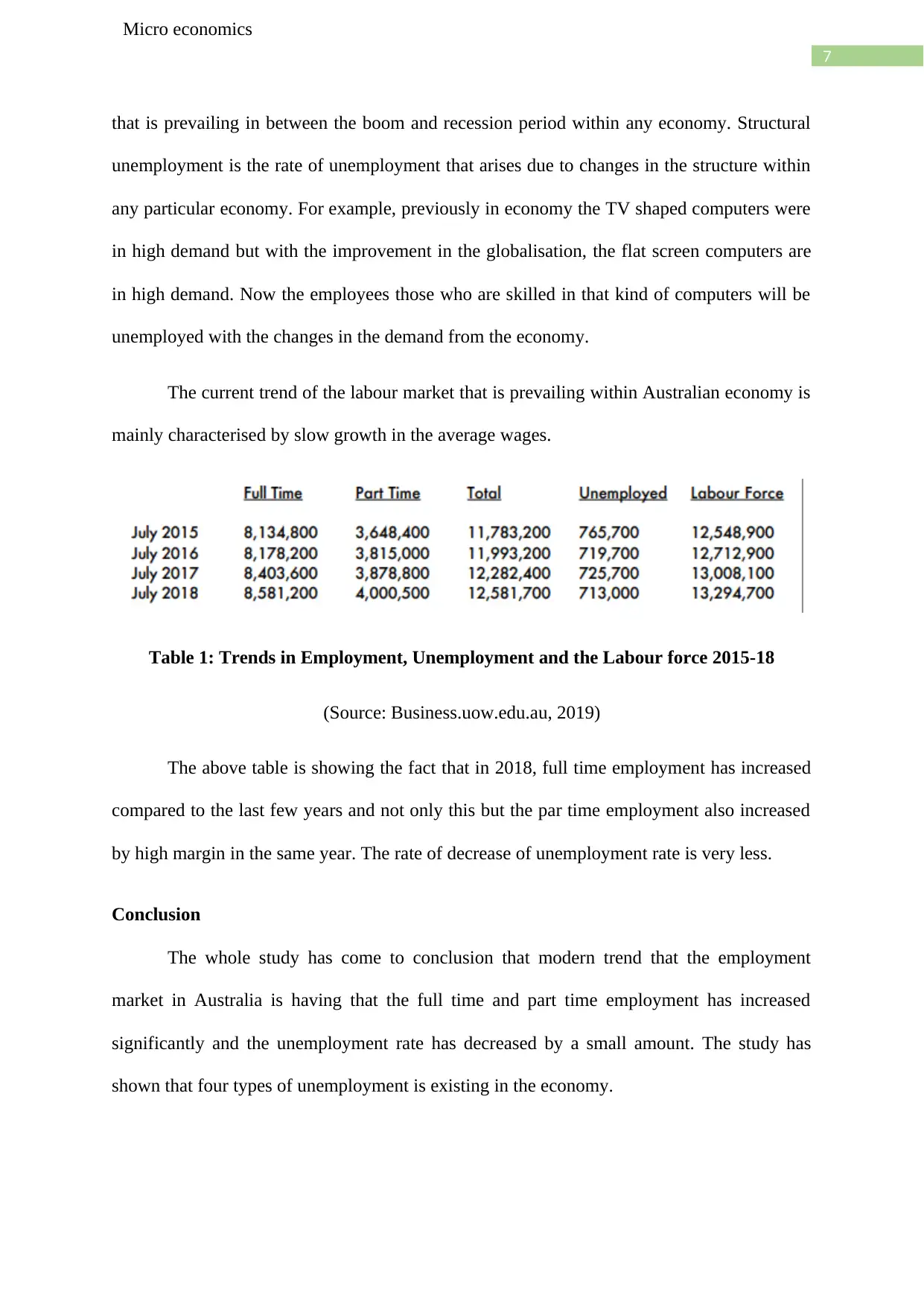
7
Micro economics
that is prevailing in between the boom and recession period within any economy. Structural
unemployment is the rate of unemployment that arises due to changes in the structure within
any particular economy. For example, previously in economy the TV shaped computers were
in high demand but with the improvement in the globalisation, the flat screen computers are
in high demand. Now the employees those who are skilled in that kind of computers will be
unemployed with the changes in the demand from the economy.
The current trend of the labour market that is prevailing within Australian economy is
mainly characterised by slow growth in the average wages.
Table 1: Trends in Employment, Unemployment and the Labour force 2015-18
(Source: Business.uow.edu.au, 2019)
The above table is showing the fact that in 2018, full time employment has increased
compared to the last few years and not only this but the par time employment also increased
by high margin in the same year. The rate of decrease of unemployment rate is very less.
Conclusion
The whole study has come to conclusion that modern trend that the employment
market in Australia is having that the full time and part time employment has increased
significantly and the unemployment rate has decreased by a small amount. The study has
shown that four types of unemployment is existing in the economy.
Micro economics
that is prevailing in between the boom and recession period within any economy. Structural
unemployment is the rate of unemployment that arises due to changes in the structure within
any particular economy. For example, previously in economy the TV shaped computers were
in high demand but with the improvement in the globalisation, the flat screen computers are
in high demand. Now the employees those who are skilled in that kind of computers will be
unemployed with the changes in the demand from the economy.
The current trend of the labour market that is prevailing within Australian economy is
mainly characterised by slow growth in the average wages.
Table 1: Trends in Employment, Unemployment and the Labour force 2015-18
(Source: Business.uow.edu.au, 2019)
The above table is showing the fact that in 2018, full time employment has increased
compared to the last few years and not only this but the par time employment also increased
by high margin in the same year. The rate of decrease of unemployment rate is very less.
Conclusion
The whole study has come to conclusion that modern trend that the employment
market in Australia is having that the full time and part time employment has increased
significantly and the unemployment rate has decreased by a small amount. The study has
shown that four types of unemployment is existing in the economy.
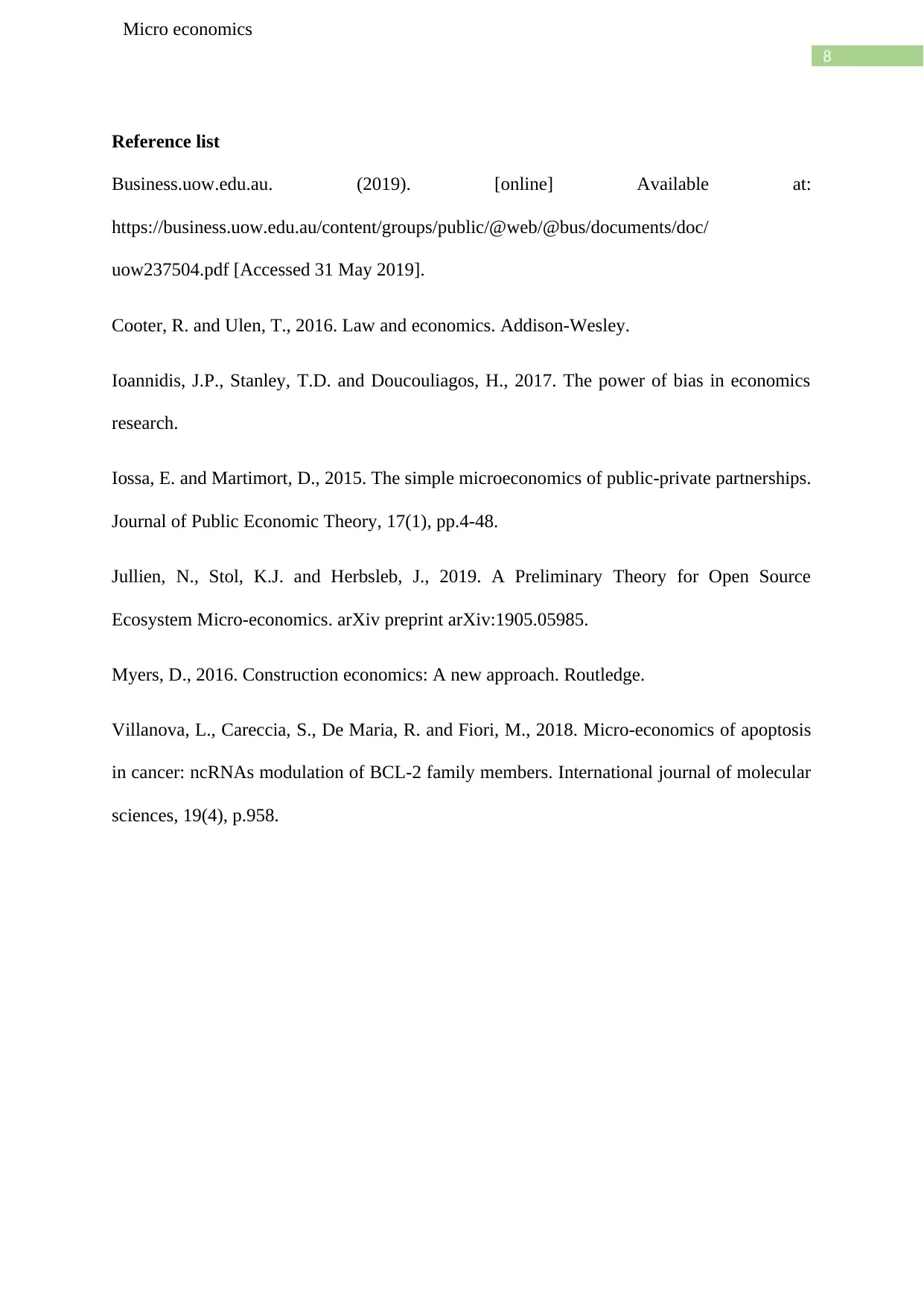
8
Micro economics
Reference list
Business.uow.edu.au. (2019). [online] Available at:
https://business.uow.edu.au/content/groups/public/@web/@bus/documents/doc/
uow237504.pdf [Accessed 31 May 2019].
Cooter, R. and Ulen, T., 2016. Law and economics. Addison-Wesley.
Ioannidis, J.P., Stanley, T.D. and Doucouliagos, H., 2017. The power of bias in economics
research.
Iossa, E. and Martimort, D., 2015. The simple microeconomics of public‐private partnerships.
Journal of Public Economic Theory, 17(1), pp.4-48.
Jullien, N., Stol, K.J. and Herbsleb, J., 2019. A Preliminary Theory for Open Source
Ecosystem Micro-economics. arXiv preprint arXiv:1905.05985.
Myers, D., 2016. Construction economics: A new approach. Routledge.
Villanova, L., Careccia, S., De Maria, R. and Fiori, M., 2018. Micro-economics of apoptosis
in cancer: ncRNAs modulation of BCL-2 family members. International journal of molecular
sciences, 19(4), p.958.
Micro economics
Reference list
Business.uow.edu.au. (2019). [online] Available at:
https://business.uow.edu.au/content/groups/public/@web/@bus/documents/doc/
uow237504.pdf [Accessed 31 May 2019].
Cooter, R. and Ulen, T., 2016. Law and economics. Addison-Wesley.
Ioannidis, J.P., Stanley, T.D. and Doucouliagos, H., 2017. The power of bias in economics
research.
Iossa, E. and Martimort, D., 2015. The simple microeconomics of public‐private partnerships.
Journal of Public Economic Theory, 17(1), pp.4-48.
Jullien, N., Stol, K.J. and Herbsleb, J., 2019. A Preliminary Theory for Open Source
Ecosystem Micro-economics. arXiv preprint arXiv:1905.05985.
Myers, D., 2016. Construction economics: A new approach. Routledge.
Villanova, L., Careccia, S., De Maria, R. and Fiori, M., 2018. Micro-economics of apoptosis
in cancer: ncRNAs modulation of BCL-2 family members. International journal of molecular
sciences, 19(4), p.958.
⊘ This is a preview!⊘
Do you want full access?
Subscribe today to unlock all pages.

Trusted by 1+ million students worldwide
1 out of 9
Related Documents
Your All-in-One AI-Powered Toolkit for Academic Success.
+13062052269
info@desklib.com
Available 24*7 on WhatsApp / Email
![[object Object]](/_next/static/media/star-bottom.7253800d.svg)
Unlock your academic potential
Copyright © 2020–2025 A2Z Services. All Rights Reserved. Developed and managed by ZUCOL.



